
views
Cleaning Your Engine and Looking for a Leak

Park your vehicle and allow it to cool down if you were just driving it. Make sure your vehicle is parked on flat and level ground and turn off the engine. If you were recently driving your vehicle, wait at least 15 minutes for the engine to cool down before you clean it. Park your vehicle in a garage or a shady spot so it cools down more quickly. Take your keys out of the ignition so there isn’t any power being drawn from the battery.Warning: Spraying water on a hot engine could potentially damage it or burn you. Hold your hand just above the engine to feel if it’s cool before you start to clean it.

Pop the hood and disconnect the negative battery terminal. Open up your hood to access your engine and locate the battery. Find the negative terminal, which will have a minus (-) sign next to it. Use a wrench to loosen the nut connecting the negative terminal and lift the cable off of the post so the battery is disconnected from your engine. Always disconnect the negative terminal to avoid creating sparks or shorting out your battery. The negative terminal is usually protected by a black covering. The positive terminal will have a plus (+) sign next to it and is generally protected by a red covering.
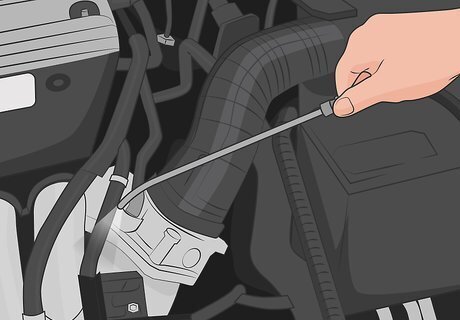
Blow out loose dirt with an air compressor. An air compressor is a machine that blows jets of concentrated air and is used to clean surfaces. Put on a pair of safety glasses, plug in your air compressor, and use the hose to blast dirt and debris out of your engine. Be sure to hit all of the nooks and crannies, as well as the undercarriage beneath your engine with the compressed air to clear out any buildup. You can purchase air compressors at home improvement stores or by ordering them online. You can also rent one for the day from your local hardware or home improvement store. Always wear safety glasses so you don’t blast dirt and debris into your eyes.
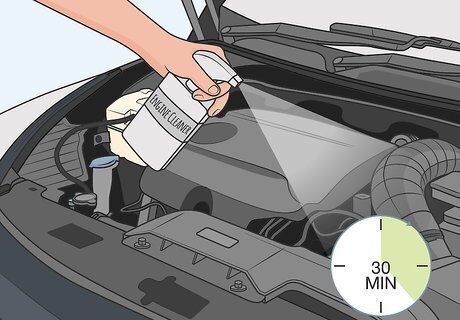
Spray engine cleaner all over the engine and let it soak for 30 minutes. Engine cleaner is a degreasing agent that is specially designed to clean off grease, grime, and oil that builds up on engines. Spray the cleaner all over your engine block according to the directions on the packaging and then get underneath your vehicle to spray the cleaner onto the engine and undercarriage from below. Let the cleaner sit so it can work to dissolve and loosen oily residue. Check the packaging to see how long you need to let the cleaner sit. Most engine cleaners need to soak on your engine for at least 30 minutes. You can find engine cleaner at your local auto supply store and by ordering it online.
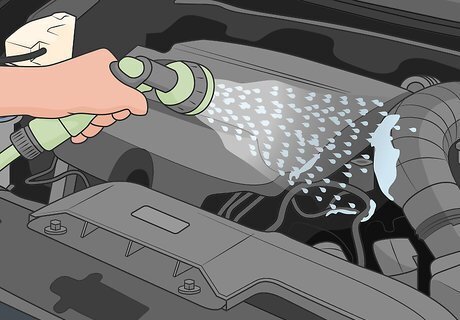
Rinse off the engine with a hose to clean off oil and grime. Take a garden hose or a pressure washer set to the lowest setting and wash away the engine cleaner and oily residue. Continue rinsing the engine from top and bottom until all of the cleaner and grime is gone so you’ll be better able to see any leaking oil. Even thought he fuse box is sealed shut, avoid spraying the fuse box directly so there’s no chance the water can affect it. Focus the stream of water on any stubborn spots of grime to rinse it away.
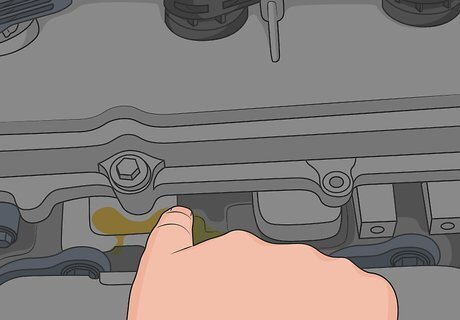
Wait 30 minutes then look above and below your engine for leaking oil. After about half an hour, any leaks in your squeaky clean engine or oil lines will be much more visible. Look all around the top of your engine, especially along the ribs on the sides and the gaskets on top. Get underneath your vehicle and check your engine from below. Check for black streams of oil or black residue on your engine. Half an hour is plenty of time to allow oil to seep through any leaks after you clean your engine. Use a flashlight if you’re having trouble seeing parts of your engine. Since you just cleaned your engine, any oil that you see will have come from a leak.

Follow the trail of oil to find the the leak. Once you find a stream or trail of black oil, check to see where it’s coming from. Follow the trail of oil to its source to find your leak. You may have to follow a winding trail deep into your engine to locate the source of your leak. Look in areas where oil leaks commonly occur such as around the enginge gaskets, the oil pan, as well as cracks along the side of the engine block. It’s definitely possible to have more than 1 leak, so keep an eye out for any additional trails or sources of leaks.
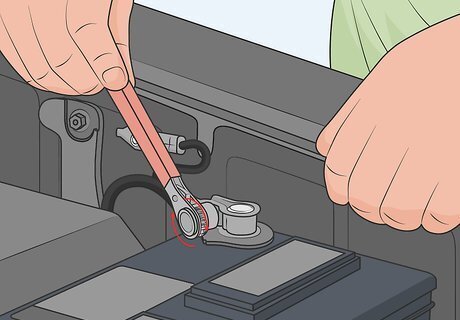
Reconnect your vehicle’s battery. Slide the negative terminal cable over the post and use a wrench to tighten the nut to hold it in place securely. Close your hood and start your car to make sure the battery is functioning properly.
Finding the Leak with UV Light
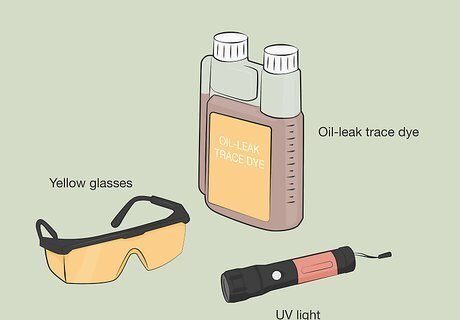
Use an oil-leak trace dye, yellow glasses, and UV light to find a leak. Oil-leak trace dye is a chemical dye that glows brightly under ultra-violet (UV) light, and is the most accurate way to pinpoint an oil leak in your engine. Use a handheld UV light and wear a pair of glasses with yellow frames so you’re able to see the trace dye under the UV light even better. Many oil-leak trace dye kits will come with the dye, a light, and yellow glasses. Look for oil-leak trace dye, UV lights, and yellow glasses at your local auto supply shop or by ordering them online.

Mix ⁄2 fluid ounce (15 mL) of trace dye with ⁄4 US quart (240 mL) of oil. The trace dye needs to run through your entire oil system. Add the dye to a small amount of your recommended engine oil so it’s diluted enough to quickly run through your oil lines. Check your vehicle’s owner’s manual or search online to find the specific oil your engine uses.
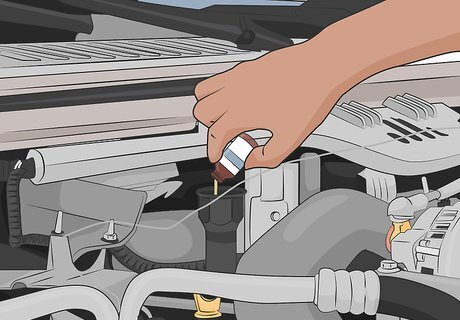
Pour the oil and dye mixture into your engine. Pop the hood of your vehicle to access the engine compartment. Locate your engine’s oil cap, which will have the symbol of an oil can on it, and remove it. Carefully add the oil and trace dye mixture into your engine and then close the cap tightly. Be careful not to spill any of the mixture onto your engine! Use a funnel to pour the mixture into your engine.

Start the engine and drive your vehicle around for 10 minutes. The oil-leak trace dye needs to run through your entire system in order to identify any leaks, so start up your engine after you add it and go for a short drive. After about 10 minutes or so, park your vehicle on flat and level ground, turn off your engine, and pop the hood so you can check for leaks. Driving your vehicle around will make sure the dye gets worked into your entire system.Note: Try to avoid muddy or dirty roads so you don’t splash any muddy water into your undercarriage.

Look for the trace dye with your UV light to identify find the leak. Put on your yellow glasses and shine your UV light all over your engine. Look for the glowing trace dye and follow it to find out where it’s leaking from. Get underneath your vehicle to look up into the engine for any of the trace dye leaking down that you can follow to the source of the leak. Knowing exactly where the oil is leaking from will make it easier for mechanics to repair it. Be sure to check around the gaskets on top of your engine and the oil pan on your undercarriage, which are where leaks commonly occur. It’s possible that there are multiple leaks, so be sure to look all around your engine as well as beneath your vehicle to check for leaks in the undercarriage.
Using Baby Powder to Find a Leak

Use baby powder as a simple and cheap way to find a leak. Though it may not be as exact or precise as using an oil-leak trace dye, baby powder is an effective way to find an oil leak in your vehicle’s engine. Find a bottle of white talcum powder, commonly used as baby powder for a safe and simple way to look for oil leaks. Check your medicine cabinet or pick up a bottle of baby powder from your local pharmacy or department store. You could also order some online as well. Tip: If you don’t have baby powder, you can use regular talcum powder, or even foot powder to check for leaks.
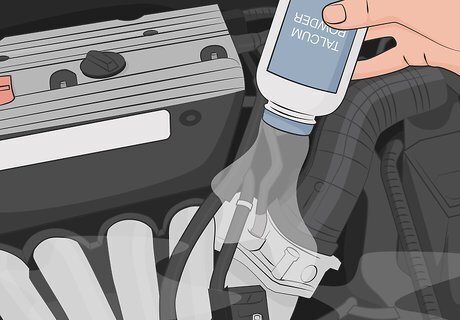
Sprinkle baby powder all over the area of a suspected leak. Pop your vehicle’s hood, take your baby powder, and sprinkle it liberally all over your vehicle’s engine. Be sure to add some to the undercarriage of your vehicle in case the oil is leaking from there as well. The baby powder won’t harm your engine, so feel free to sprinkle it everywhere on your engine! Talcum powder is carcinogenic, so be careful not to inhale any of the powder while you’re sprinkling it.

Drive the vehicle around for about 5 minutes. Start up your engine and take your vehicle for a short drive. After about 5 minutes or so, the oil moving through the lines will start to exit through the leaks if there are any so you’ll be able to find them. 5 minutes is enough time to allow the oil to leak out without heating up your engine so much that it’s too hot to inspect. Don’t drive around if it’s raining and avoid roads with lots of puddles so the water doesn’t wash away the powder.
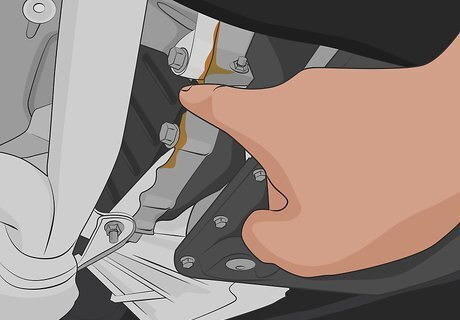
Check the engine for a stream of oil and follow it to find your leak. Park your vehicle and turn off the engine. Pop the hood and look around for any dark liquid on the white baby powder. Get underneath your vehicle as well to check the undercarriage for leaks. If you find streaks of oil, follow the streaks to where they originate to find the location of your leak. Knowing the location of your leaks will help mechanics repair it. Check all around your engine to make sure there aren’t multiple leaks.



















Comments
0 comment